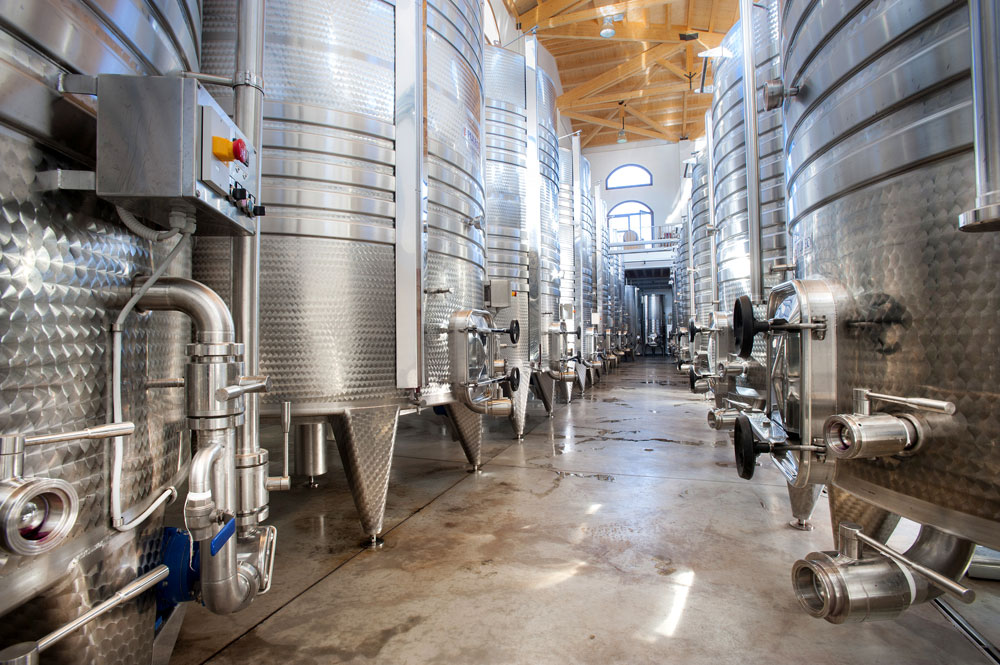“What’s the difference between red and white wine?” The question seems to answer itself, right? There are, in fact, real differences in the way they are made. This post will go behind the scenes to explore some of the factors that make these two styles unique.
Modern White Wines Are Generally Made Without Their Grape Skins

As we’ve discussed in previous posts, the pigment in red wine comes from the skin of the grapes. What you might not realize is that white grapes are normally made entirely without the skins. Whereas red grapes are crushed and soaked with the skins in a process called “maceration,” white grapes are usually removed from their skins right away so that the grape juice can ferment on its own. If white grapes are macerated with their skins in the same manner as red grapes, they don’t actually come out white. Contrary to linguistic implications, white grapes are not actually white. They are generally greenish but can also come in various shades of orange, yellow, and pink.
Before the advent of modern winemaking techniques in the twentieth century, most “white” wines were much darker and cloudier than they are today. They even contained noticeable levels of tannin from the grape skins.
Oak Is More Commonly Used For Red Wines

Before the invention of stainless steel vats and other modern materials, winemakers seldom had a choice but to use oak barrels to hold wine. They would use oak for fermentation, transportation, and aging of wine which had a marked influence on flavor and style. Oak adds flavors to wine like vanilla, coconut, and baking spice. It also allows for additional air contact between the wine and outside air, speeding the aging process and further changing the flavors and aromas. Modern winemaking techniques have made oak fermentation and aging an option, rather than a necessity. With a few notable exceptions like California Chardonnay, white wines are made without oak. Red wines can also be made without oak influence, but it’s unusual. The majority of red wines see at least a little oak.
Malolactic Fermentation Is More Common In Red Wine

In addition to the standard alcoholic fermentation, many wines go through a process called “malolactic fermentation” – or “malo” for short – wherein tart, fruity, malic acid in the wine is converted to softer lactic acid. Historically, malolactic fermentation wasn’t understood by science and happened randomly after alcoholic fermentation in the majority of wines, regardless of if they were red or white. Currently, winemakers encourage malo in nearly all red wines but prevent it in the vast majority of whites. Once again, California Chardonnay is an exception with buttery lactic acid flavors being prized in many examples. Aside from Chardonnay, malolactic fermentation is very rare with white wines because it tends to diminish the flavor of fresh tart fruit in favor of a soft buttery texture and flavor.
Red Wines Are Often Aged Longer Than Whites

Red wines are aged for a variety of reasons. Sometimes, local laws require aging, or the tannins are too harsh and need to be softened with additional time in barrel or bottle. Aging also tends to diminish fresh fruit flavors and promote characteristics like dried fruit, spice, earth, leather, etc. The current trend for white wine is to emphasize the fresh fruit character of the wine, so aging is seldom considered beneficial. There are always exceptions to this rule, with various types of white wines that are meant to be aged and enjoyed for years to come (including Clare Valley Riesling, Chablis, varieties from the Languedoc region, and Sauternes). Most white wines are meant to be enjoyed from one to three years after release, while many reds are expected to age for a longer period.
Hopefully, this post provides you with some insight into the differences between red and white wine and allows you to appreciate both even more.



